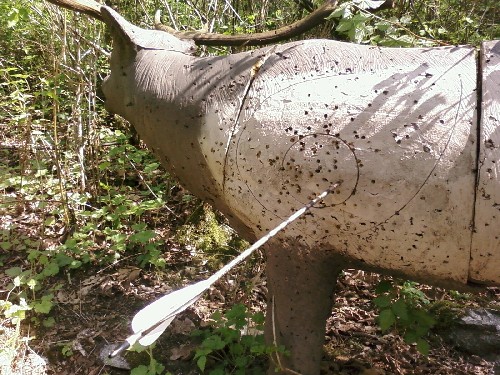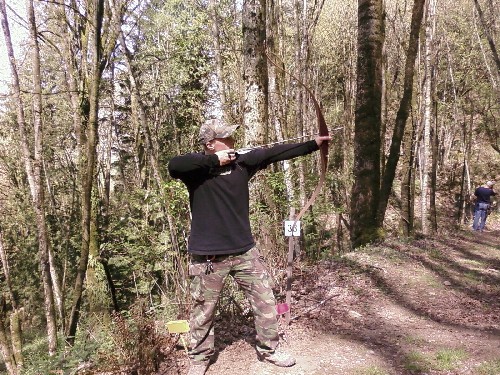Traditional Bow Hunting
Traditional Archery
Bow hunting is undoubtedly the best and most effective means of sustainable utilization of wild life in the long term with minimum impact on the environment as compared to all other forms of hunting. It is a specialized form of hunting that yet remains vastly underutilized.
Bow hunting in Canada, the United States, and many parts of the world is done from blinds or stands that are located close to feed or water areas frequented by game animals. This is more or less a universally accepted practice. Research data reveals that of all hunters some thirty percent are bow hunters. It cannot be denied that cropping of animals with the bow and arrow puts far less stress on wild life than rifle hunting, especially in game areas that are small. Bow hunting requires very little infrastructure causing lesser disturbance to the environment.
Traditional bow hunting means using primitive archery tackle. This proves to be even more challenging than using modern bow hunting gear. You have to be more instinctual as you do not have sights to pin point your arrow flight and to make it more physically challenging, there is no “let off” when you are at full draw. Your range with traditional archery equipment is far less than when using a modern compound bow. Arrow flight is not as flat with traditional archery tackle as you are launching a heavier projectile at a slower speed than a carbon arrow out of a compound bow.
The gear and equipment for traditional bow hunting would include your stick bow, set of arrows, quiver, finger tab, and arm protector. Stick bows are traditional wooden bows that may either be longbows or recurve bows made out of laminated strips of wood. Longbows, as the name suggests, are fairly tall, roughly equaling the height of the user, have narrow limbs that are D shaped or round in cross-section. They have a draw length reaching the ear or further. Recurve bows in contrast to longbows have their tips curving away from the shooter in the unstrung position. When strung, the tips curve inwards towards the shooter to pack more energy to deliver to the arrow when the string is released. A recurve bow is much shorter and faster. However, it is heavier in weight. Arrows must also be selected with extreme care. Wooden arrows are a fundamental part of traditional archery. They give a magical feeling that cannot be matched by aluminum or carbon shafts. Many people believe that wooden shaft arrows cannot fly straight. However, with modern technology, high grade wood and spine, wooden arrows have a consistent flight. Arrow shafts are available in woods like cedar, Sitka spruce and Douglas fir. The feather fletching is to stabilize and impart a spin to the arrow supporting it to follow its trajectory. Usually goose and turkey feathers, either wild or domestic are used for the fletching. As per standard dimensions, three-vane feather fletching should be 5 inches long and 5/8 inches in height whereas four-vane fletching should be 4 inches long and 5/8 inches in height. The broadheads typically used for traditional archery hunting are 2 blade, 1 piece, glue-on broadheads.
 Before you go out and try to bag a trophy big game animal, you will need to ensure that you can shoot consistently accurate, and the best way to do this is to sharpen your shooting skills through constant practice using 3D targets. Good ones have a life size outline of the vital section of some animal. Make a month long practice schedule and for the first few days, taking along your arrows and shoot as much as you can at a blank bale at chest level. No aiming, just feel the shot, pulling the bow by applying steady pressure. Relax while shooting, and once you become comfortable, try shooting with your eyes closed. Then change the routine to shoot at the blank bale for ten minutes followed by another half hour shooting at the target. Continue shooting at the target as long as you can shoot smoothly. Then try practicing to shoot from different elevations. Shot placements will be different with a change in angles. Keep increasing your distance from the target progressively until there appears a marginal shot placement consistency. Then work back slowly till you get to shoot tight arrow groups at the target’s kill zone. This is your effective range. Make a note of it and train yourself not to shoot at animals beyond this distance.
Before you go out and try to bag a trophy big game animal, you will need to ensure that you can shoot consistently accurate, and the best way to do this is to sharpen your shooting skills through constant practice using 3D targets. Good ones have a life size outline of the vital section of some animal. Make a month long practice schedule and for the first few days, taking along your arrows and shoot as much as you can at a blank bale at chest level. No aiming, just feel the shot, pulling the bow by applying steady pressure. Relax while shooting, and once you become comfortable, try shooting with your eyes closed. Then change the routine to shoot at the blank bale for ten minutes followed by another half hour shooting at the target. Continue shooting at the target as long as you can shoot smoothly. Then try practicing to shoot from different elevations. Shot placements will be different with a change in angles. Keep increasing your distance from the target progressively until there appears a marginal shot placement consistency. Then work back slowly till you get to shoot tight arrow groups at the target’s kill zone. This is your effective range. Make a note of it and train yourself not to shoot at animals beyond this distance.
While hunting, never shoot from outside your effective range and always use the right equipment with sharp broad heads. Shoot only when you are sure of proper shot placement. The chest area is best on a frontal shot; the heart/lung area is best on a broadside shot. Shoot to make a quick humane kill. Do not just wound the animal and leave it to die. If wounded, follow the animal until you find it. Avoid headshots. The shot may ricochet off the hard skull to cause wounding and later a slow painful death.
Traditional Archery Links:



